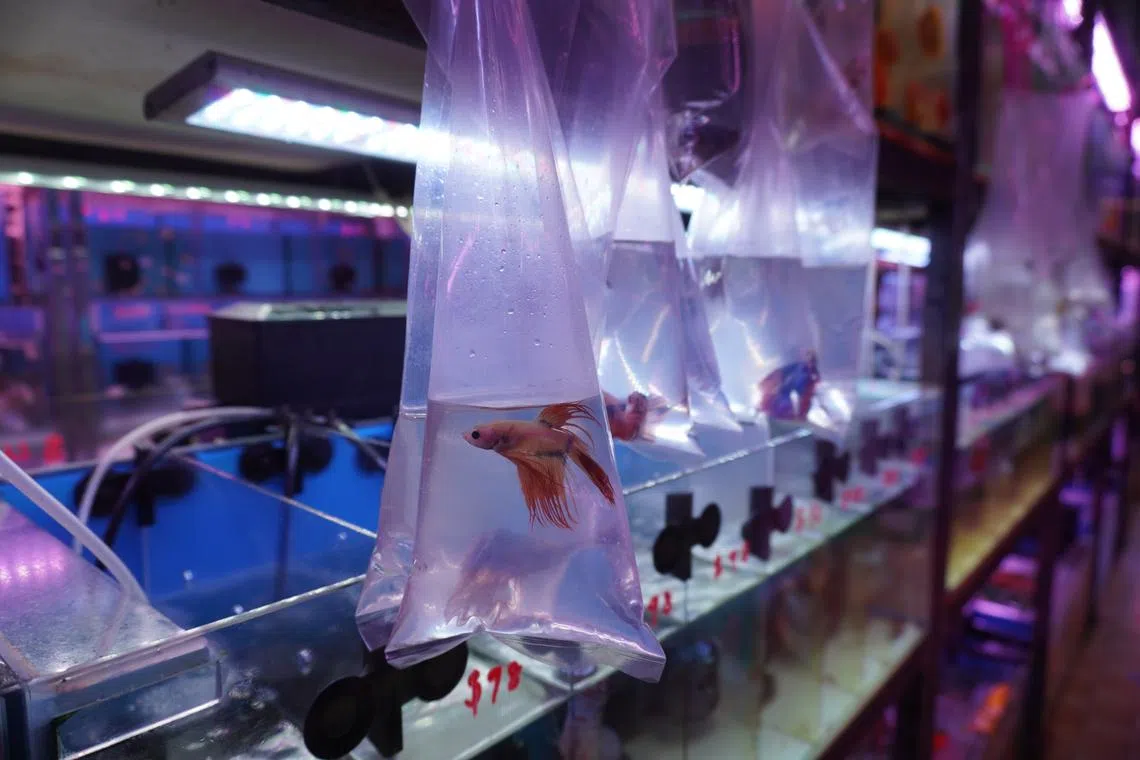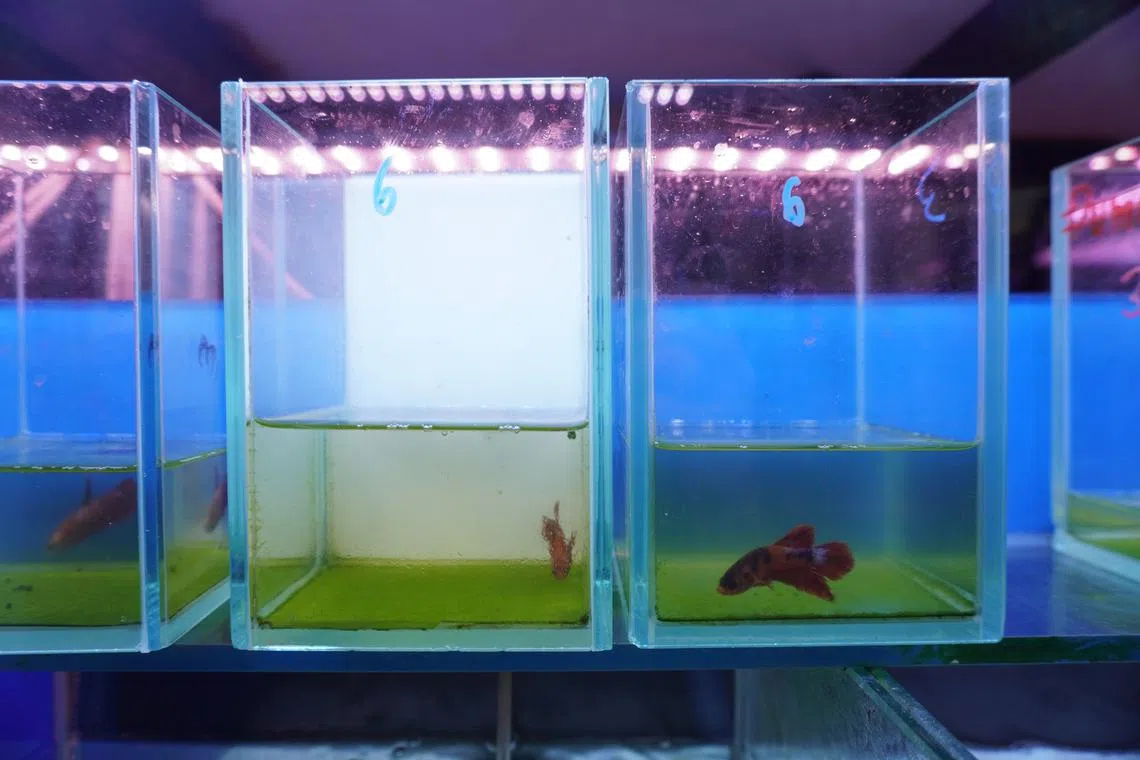Study calls for larger tanks, better environment for Betta fish in pet shops, home aquariums
Sign up now: Get ST's newsletters delivered to your inbox

Tanks with gravel, plants and hideouts provide resting spots for the fish where they can hide.
PHOTO: NAOMI CLARK-SHEN
Follow topic:
SINGAPORE – A new study in Singapore found that Betta fish – also known as Siamese fighting fish – should be kept in a minimum tank size of 5.6 litres when displayed for sale and it should contain gravel, live plants and hideouts to ensure their welfare.
This provides sufficient space for the fish to swim around, while a variety of accessories helps simulate their natural environment.
But in pet stores, these popular pet fish, known for their striking colours and flamboyant fins and tails, are often kept in small tanks or even plastic bags, leaving them with insufficient space to swim around.
The study by a team of marine scientists from Singapore, Australia and France examined the impact of housing size and furnishings on the behaviour of Betta fish to understand optimal tank conditions. It was published in the scientific journal Animal Welfare in November 2024.
Betta fish are known as fighting fish because they are territorial and aggressive. The small-sized fish with iridescent bodies and multi-hued tails are typically kept singly to prevent them from attacking one another.
Native to Thailand, the fish can also be found in other South-east Asian countries such as Malaysia, Indonesia and Cambodia.
The study noted that Thailand is one of the world’s biggest suppliers of the fish, with more than 1,000 Betta fish farms there exporting over 20 million fish in 2018. Singapore is among the top importers, it added.
Its lead researcher, Dr Naomi Clark-Shen, recalled seeing these fish in “very small, empty jars” on trips to aquarium shops here about two decades ago.
Conditions have not changed much, as she has observed that they are still being sold in small, empty cups, jars and even plastic bags.

Betta fish are sometimes kept in plastic bags in pet shops.
PHOTO: NAOMI CLARK-SHEN
“Siamese fighting fish are treated like ornaments and not living creatures,” said Dr Clark-Shen, who heads the ocean-climate programme at Rumah Foundation, the philanthropic arm of Rumah Group, a family office in Singapore for sustainable investments and conservation projects.
“Fish do not have expressive faces and cannot vocalise their emotions like dogs and cats can. I think a lot of people think fish are not sentient and do not feel emotions.”
The study, which saw 13 male Betta fish placed in five different habitats for 31 days, found that fish in the large tanks were more active and spent less time resting and displaying abnormal behaviour – such as hovering – when compared with those in smaller tanks.
Five tanks were used in the study: 1.5-litre, 3.3-litre, 5.6-litre and 19.3-litre tanks furnished with gravel and plants, and a fifth 19.3 litre tank that was barren.
More inactivity was observed in the smaller tanks, which could reflect that the fish were experiencing boredom. Fish in smaller tanks and the barren tank also displayed abnormal behaviour like hovering and stereotypic swimming, which refers to moving repetitively with no clear objective, like pacing back and forth and circling.
Dr Clark-Shen said such behaviour is not normally seen in the wild and may be due to stress and poor welfare.

A new study found that Betta fish in large tanks were more active and spent less time resting and displaying abnormal behaviour when compared with those in smaller tanks.
PHOTO: NAOMI CLARK-SHEN
Meanwhile, the fish foraged the most in the largest tank – which is a natural behaviour and is a sign of positive welfare, said the study.
The fish also displayed more “abnormal” behaviour like interacting with the walls and swimming less in the barren tank, as compared with the tanks with furnishings. Plants, hideouts and gravel not only kept them active but also provided resting spots for the fish where they could hide to feel secure, according to the study.
Based on the findings, the authors recommend a minimum tank size of 5.6 litres for the display and sale of Betta fish in shops, and tanks larger than that when keeping them at home. All tanks should also contain gravel, live plants and hideouts.
In response to queries from The Straits Times, the Animal and Veterinary Service (AVS) said that pet shops licensed by AVS are required to abide by the licensing conditions regarding the housing and environment of Betta fish.
AVS said this includes keeping them in tanks of “adequate” size – but did not specify the size – and ensuring there is no overcrowding. Tanks and containers must be clean and in good condition, and the water quality must also be properly maintained.
AVS, a cluster under the National Parks Board, also said that it has not received any feedback on concerns over the welfare of Betta fish in the past five years.
Dr Clark-Shen said she hopes the study will prompt countries to review their laws and prohibit the display of these fish in barren bags, cups and small jars. But even if the recommendations are not adopted into law, she hopes that businesses can follow the recommendations when displaying Betta fish for sale.
“We need to create a society where animals are not treated like commodities but are treated with more compassion and respect,” she said.


